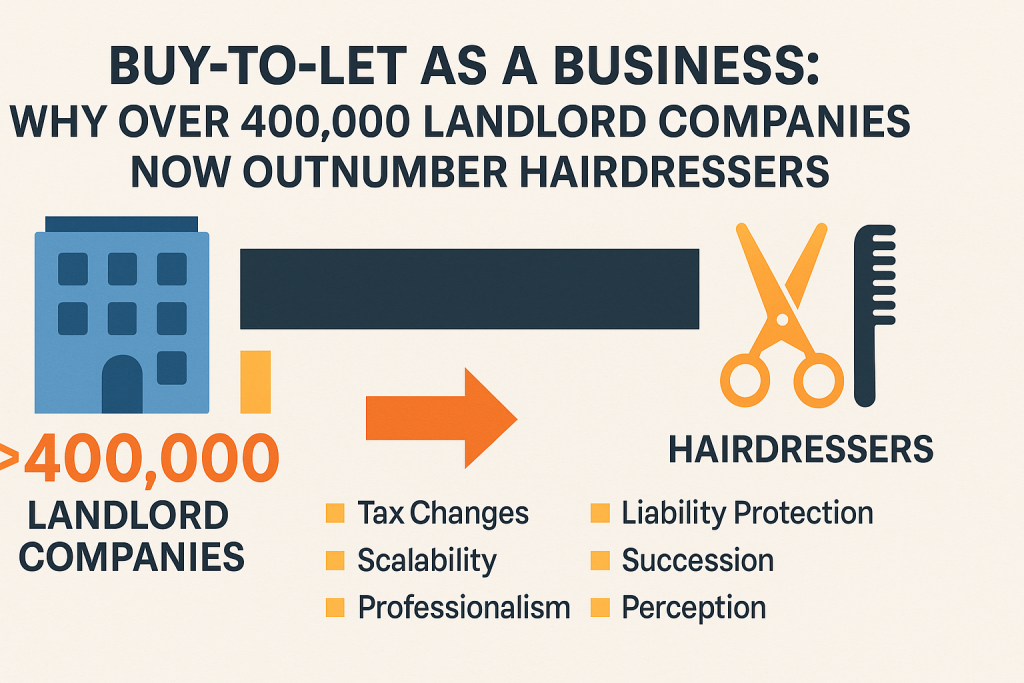Buy-to-Let as a Business: Why Over 400,000 Landlord Companies Now Outnumber Hairdressers
In a striking twist to the UK business landscape, over 400,000 companies are now registered to hold buy-to-let property — making them the single largest category of business entities at Companies House, even outnumbering hairdressers. This is not just a quirky statistic — it marks a structural change in how landlords operate. They’re increasingly running property investment the way other businesses run their operations: in corporate form.
Let’s unpack why this shift is accelerating — and what it means for landlords, investors, and the rental market.

1. The tectonic shift: tax, structure and scale
Tax reform as the pivot
The turning point begins with changes introduced from 2016 onwards, when full mortgage interest tax relief for buy-to-let landlords in personal names was withdrawn. The relief was phased out, and replaced by a 20 per cent tax credit, significantly disadvantaging higher-rate and additional-rate taxpayers.
Over the ensuing years, more and more landlords began shifting property holdings into limited companies, where mortgage interest can be treated as a deductible business expense. Thus, a structure that was once mainly used by large portfolio landlords is now being adopted by smaller investors too.
Scale and momentum
Between February 2016 and February 2025, the number of buy-to-let companies soared from ~ 92,975 to 401,744 — a rise of 332 per cent. In 2024 alone, a record 61,517 new limited companies were set up to hold rental properties — a 23 per cent increase over the previous record year.
It’s estimated that 70–75 per cent of new buy-to-let purchases now go into a limited company structure. There are currently around 680,000 properties held in such corporate structures across England and Wales, rising by 70,000–100,000 annually (not all new acquisitions — many are existing properties being transferred).
The net result: more companies exist to hold property than for any other single business purpose — including services like hairdressing or fast food.
Why landlords are treating buy-to-let like a business
This is no longer just about bricks and mortar — landlords are adopting business thinking for many reasons:
Tax efficiency
In a limited company, interest and financing costs are deductible before tax. The company is subject to corporation tax (generally lower than higher income tax rates) on its profits. That can help preserve cash flows and returns, especially for those exposed to higher-rate personal tax.Profit extraction flexibility
Dividends, salaries, and other forms of remuneration allow more sophisticated tax planning (e.g. utilising tax-free dividends, allowances, etc.).Liability protection
Operating via a company can help isolate personal assets from risk exposure associated with property business (though in practice many landlords still provide guarantees or have joint personal-company liability).Growth mindset and scalability
Investors managing multiple properties often find it more straightforward to consolidate under a corporate umbrella, streamline bookkeeping, and scale operations.Succession & estate planning
Owning property through a company can (in many cases) simplify the transfer of value, inheritance tax planning, and retaining control through share ownership.Perception and professionalism
More landlords are positioning themselves as property businesses rather than “amateurs” letting out a spare house — operating with dedicated governance, finance, and management systems.
3. Risks, friction and counterbalances
While the trend is strong, it is not without caveats:
Stamp duty & transfer costs
Moving a property from personal name into a company incurs additional stamp duty surcharges, which can erode the financial case, especially for existing properties.Mortgage availability and costs
Lending into limited companies tends to carry higher rates and stricter underwriting, especially for smaller landlords.Administrative burden
Running a company brings responsibilities — accounting, filing, corporate governance, compliance, potential audit risk.Marginal benefit for smaller landlords
For single-property investors or people on lower tax rates, the complexity and costs may outweigh the advantages.Regulatory shifts
Any changes in tax law, stamp duty or corporate rules could reverse or reduce the benefits of the structure.Market headwinds
Rising interest rates, slowing rental growth, and tighter regulation may squeeze margins. Indeed, the number of new buy-to-let mortgages has halved in just over a year — a signal that new acquisitions are already under pressure.Exit taxation
When the property is eventually sold, extracting value from the company (via dividends, liquidation, or sale of shares) may incur tax consequences (capital gains tax, corporation tax on chargeable gains, etc.).
4. Structural consequences for the rental market
This shift toward corporate landlordism carries broader implications for the private rented sector:
Concentration and professionalism
As more landlords adopt company form, dominated by scale, the PRS may become more uniform, efficient — but also possibly less personal and more homogenised in approach.Barrier to small-scale entry
The upfront complexity and costs may deter “casual” landlords, raising the threshold to entry and favouring serious, well-capitalised operators.Regulatory and political scrutiny
With so many corporate landlords, scrutiny from regulators and tenants is likely to intensify — on transparency, standards, rights, etc.Valuation and capital flows
As corporate landlords behave more like institutional investors, capital allocation in the sector may become more dynamic. There might be more asset-level transactions, portfolio reshuffles, and structurally more capital chasing PRS assets.Shifting narrative
The notion of the “residential landlord” may gradually merge into the concept of the “property business” — altering how stakeholders (tenants, policymakers, banks) perceive and regulate the sector.
5. What should landlords and investors be thinking now?
If you’re a landlord—or planning to become one—these shifts demand attention. Here are a few strategic considerations:
Do the numbers
Run comparison models: your particular tax rates, interest burden, holding periods, exit plans. The move to corporate may make sense for many, but not all.Stage your transition
You don’t have to transform in one leap. Some landlords adopt hybrid models or gradually transition selected properties.Mind the costs
Be alert to stamp duty surcharges, transfer taxes, mortgage cost premium, accounting and compliance overheads.Align structure with strategy
If your goal is growth, a corporate setup may better support scale. If you’re holding a single property, simplicity may still win.Stay agile
Given how sensitive this dynamic is to tax and regulatory change, build flexibility into your structure and stay informed.Governance matters
As your property business becomes more complex, treat it like one — good accounting, controls, professional advice.
Conclusion
The fact that buy-to-let companies now outnumber hairdressers is more than a surprising statistic — it signals a tectonic shift in the residential property sector. Landlords are embracing the language, tools, and structures of business in order to survive and thrive in a tougher tax and regulatory environment.
For investors, landlords and advisors alike, this is a moment of transition. The strategies you choose now — how you structure, scale, and govern your portfolio — will shape your resilience in what is becoming a distinctly corporate-style real estate landscape.
Citations
The Guardian – Buy-to-let firms become biggest single type of business in UK, data shows (March 2025)
https://www.theguardian.com/money/2025/mar/17/buy-to-let-firms-become-biggest-single-type-of-business-in-uk-data-showsHamptons – February 2025 Lettings Index
https://www.hamptons.co.uk/articles/february-2025-lettings-indexLandlordZONE – More companies are registered to hold buy-to-let property than for any other type of business (March 2025)
https://www.landlordzone.co.uk/news/more-companies-are-registered-to-hold-buy-to-let-property-than-for-any-other-type-of-businessSimply Business – Record number of buy-to-let companies registered in 2024 (March 2025)
https://www.simplybusiness.co.uk/knowledge/landlord-tax/record-number-of-btl-companies/Mortgage Solutions – Number of BTL companies passes 400k as registrations outnumber other firms – Hamptons (March 2025)
https://www.mortgagesolutions.co.uk/news/2025/03/17/number-of-btl-companies-passes-400k-as-registrations-outnumber-other-firms-hamptons/The Guardian – Number of new UK buy-to-let mortgages halves in just over a year (July 2024)
https://www.theguardian.com/money/article/2024/jul/22/number-of-new-uk-buy-to-let-mortgages-halves-in-just-over-a-year
